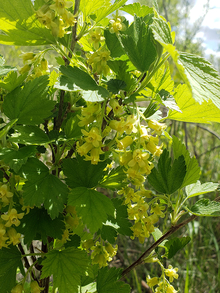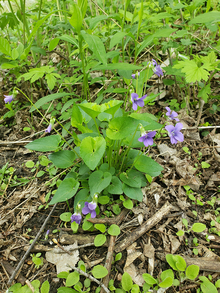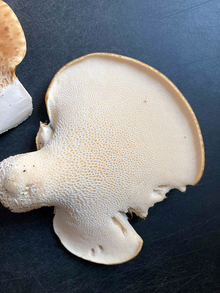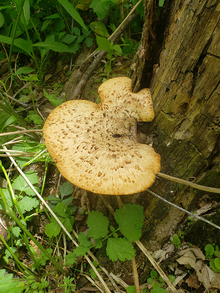Over the weekend, I left the city to visit my family in southwestern Minnesota. My dad and I hiked to a series of paths winding between the Crow River, two miles from town. The trail was filled with animals, fish and plants to forage.
Wild black currants
Our first plant sighting was wild black currants (Ribes americanum). Currants grow near standing water in partial or full sunlight. Currant species in Minnesota such as the wild black currants are found throughout the state. Skunk currant (Ribes glandulosum), northern black currant (Ribes hudsonianum), prickly currant (Ribes lacustre), and swamp red currant (Ribes triste), primarily found in the north half of the state, can be easily identified by their maple-leaf shaped leaves.
Currant leaves have three to five lobes, veins coming out from the base of the leaf, and a strong musty odor similar to cat urine when rubbed together. Currant flowers come in a variety of colors, such as red, pink, white and yellow but will almost always be seen in bundles of more than five.
Currants and gooseberries are in the same genus (Ribes), but gooseberries have a thorny stem while currants do not. I enjoy eating the flowers alone, but they can also be used in syrups, teas and jellies. They can add a slightly floral flavor.
Wild violets
As we continued our walk down the trail, we started to notice the ground was littered with tiny purple (Viola sororia) and yellow (Viola pubescens) wild violets. These flowers are the perfect addition to currant syrup (and even lemonade), providing a bright purple color and slightly floral taste.
Wild violets grow in partial shade to full sun and are often seen along woodland trails and edges due to the light, and moisture level. Harvest this plant when it is in bloom. It is easily identified from above by their bright purple color, white throat, and heart-shaped leaves.
Lesser celandine (Ficaria verna) has very similar leaves to wild violets and can be toxic. But its flower looks completely different (similar to a yellow daisy) so can be told apart when blooming. Although lesser celandine is not widespread in Minnesota currently, it has been seen in the state and is an invasive species.
Morels
Although harvesting floral edibles to make syrups and drinks can be fun, mushrooms can be added to a main course and used as a meat substitute. While harvesting fungi, positive identification is extremely important, as many have toxic lookalikes.
In prime morel (Morchella esculenta) season, make sure to check every dead hardwood tree (primarily dead deciduous trees) you come across. A common myth is that morels only grow near dead elms, but morels grow by multiple different species of dead hardwood trees including elms, oaks, maples, ashes and apples. Dead hardwoods and morels maintain a symbiosis where the tree provides nutrients to the fungi and in return, the morel creates more surface area with its mycorrhizae for the tree to absorb nutrients.
When the tree dies and there is consistent moisture and warm temperatures (between 50F and 70F) in the spring, the morels begin to reproduce, pushing their fruiting bodies above the ground to release spores. Normally they can be identified by the ridged honeycomb appearance of their caps.
Although there are several toxic lookalikes of this mushroom, such as those in the Verpa and Gyromitra families, morels can be differentiated by their hollow stem and the connection of their cap all along the stem, not just at the top. If you want to know more about mushroom hunting in Minnesota, the MN Mycological Society is a knowledgeable source.
Pheasant back mushrooms
As we came to the end of the trail, my dad and I decided to head back. Immediately after saying that we should call it a day, we spied several pheasant back mushrooms growing at the base of a dead tree right in front of us.
Pheasant back mushrooms (also called dryad’s saddle) (Polyporus squamosus) grow on dead hardwood trees although they can also be found growing on live trees. Much like their namesake, pheasant back mushrooms have the coloration of a pheasant’s feathers. Along with their coloration, pheasant backs are polypores, so they have a distinctive pore-like appearance on the bottom of their caps, and no toxic look-alikes if identified by their coloration and pores.
Pheasant back's age can be determined by their size, coloration and pore size. A mushroom smaller than the palm of your hand, with vibrant coloration and small underside pores, will have a taste similar to white meat and can end up being a great addition to stir-frys, or dried and made into jerky.
As pheasant backs mature, the pores begin to open, releasing spores for reproduction, the mushroom loses color and the base of the mushroom becomes woodier. Although the edges of mature mushrooms can be cut off and eaten as young ones are, more mature mushrooms are usually better suited to be ground into powders or used in soup stocks. Considering the pheasant back’s I encountered lost much of their color and were quite large, I decided it was best to leave them until they regrow next year.
As we walked back out to the highway, Dad and I were amazed at not only the array of foraging goods but also at the abundance of wildlife we saw. Although we only walked a few hundred meters over the course of an hour, my dad has been talking about our trip all week and can’t wait to go on another foraging adventure.
For a great Minnesota foraging reference, check out the Minnesota Harvester Handbook.
- Marrone, T. (2019, July/August). Bountiful Berries. Minnesota Conservation Volunteer.
- Swearingen, J., C. Bargeron. 2016 Invasive Plant Atlas of the United States. University of Georgia Center for Invasive Species and Ecosystem Health. http://www.invasiveplantatlas.org/






